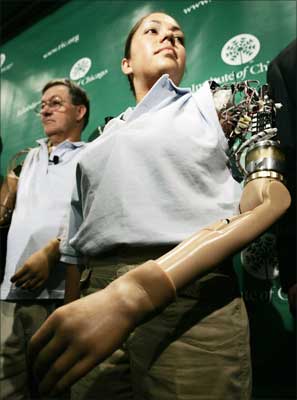Re-wiring brings back touch for amputated limb
Surgery opens door to prosthetics that can 'feel'.
Heidi Ledford
Claudia Mitchell's prosthetic arm works on her thoughts.
CALEB JONES/AP/EMPICS
Surgeons have managed to give an amputee not only a prosthetic arm that moves as directed by her thoughts, but also the feeling of touch — albeit in the wrong part of her body.
When Claudia Mitchell presses an area on her chest, where surgeons re-wired the nerves that used to run to her hand, it feels to her as if her fingers are being touched.
The technique opens the door to additional technologies that could one day relay signals from the prosthesis back to the 'fingers' on the chest, allowing an amputee to get sensory information such as touch and temperature from their artificial limb.
Mitchell's success story was revealed in a press conference last year, but now the details have been published: they are reported this week in the Lancet.1
Re-wire
Mitchell was only 24 years old when a motorcycle accident robbed her of her left arm. She got a prosthesis five months later, but wore it infrequently and then only for cosmetic reasons. It just wasn't useful enough to make the discomfort worthwhile, she said.
The nerves that used to run to Mitchell's hand were still intact. They ran to the point of amputation and could receive input from the brain, but had nowhere to send their signals. Todd Kuiken of the Rehabilitation Institute of Chicago and his colleagues moved these nerves and placed them in the muscle above Mitchell's left breast.
Three months after the surgery, the muscles in Mitchell's chest twitched when she tried to close her missing hand or bend her phantom elbow — a sign that nerve function was recovering. Another three months after that, and Mitchell was fitted with a prosthetic arm that could, through detectors on her chest and computer processors, translate those muscle twitches into the appropriate actions. She can therefore operate the prosthesis by thinking about the motions she wants to make — much as she did before the amputation.
Kuiken and his colleagues have created similar arms for three other patients, but Mitchell's operation was their first attempt to move sensory nerves to the chest as well, allowing Mitchell to feel her 'fingers' again. The move was inspired by their first surgery, in which a few sensory nerves spontaneously rerouted to the patient's chest.
Surgery opens door to prosthetics that can 'feel'.
Heidi Ledford
Claudia Mitchell's prosthetic arm works on her thoughts.
CALEB JONES/AP/EMPICS
Surgeons have managed to give an amputee not only a prosthetic arm that moves as directed by her thoughts, but also the feeling of touch — albeit in the wrong part of her body.
When Claudia Mitchell presses an area on her chest, where surgeons re-wired the nerves that used to run to her hand, it feels to her as if her fingers are being touched.
The technique opens the door to additional technologies that could one day relay signals from the prosthesis back to the 'fingers' on the chest, allowing an amputee to get sensory information such as touch and temperature from their artificial limb.
Mitchell's success story was revealed in a press conference last year, but now the details have been published: they are reported this week in the Lancet.1
Re-wire
Mitchell was only 24 years old when a motorcycle accident robbed her of her left arm. She got a prosthesis five months later, but wore it infrequently and then only for cosmetic reasons. It just wasn't useful enough to make the discomfort worthwhile, she said.
The nerves that used to run to Mitchell's hand were still intact. They ran to the point of amputation and could receive input from the brain, but had nowhere to send their signals. Todd Kuiken of the Rehabilitation Institute of Chicago and his colleagues moved these nerves and placed them in the muscle above Mitchell's left breast.
Three months after the surgery, the muscles in Mitchell's chest twitched when she tried to close her missing hand or bend her phantom elbow — a sign that nerve function was recovering. Another three months after that, and Mitchell was fitted with a prosthetic arm that could, through detectors on her chest and computer processors, translate those muscle twitches into the appropriate actions. She can therefore operate the prosthesis by thinking about the motions she wants to make — much as she did before the amputation.
Kuiken and his colleagues have created similar arms for three other patients, but Mitchell's operation was their first attempt to move sensory nerves to the chest as well, allowing Mitchell to feel her 'fingers' again. The move was inspired by their first surgery, in which a few sensory nerves spontaneously rerouted to the patient's chest.






Comment